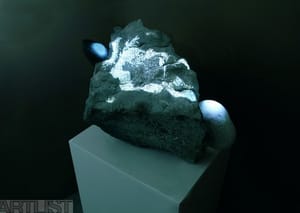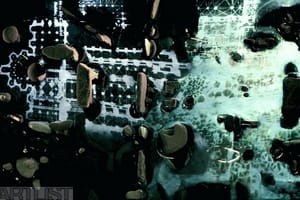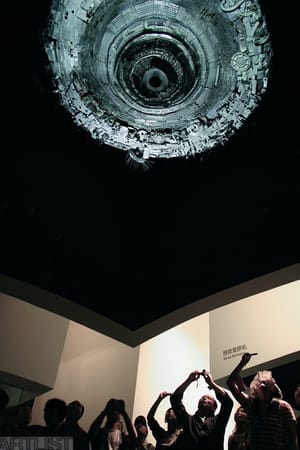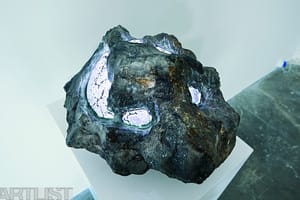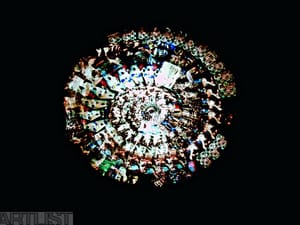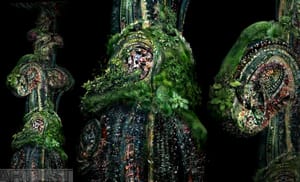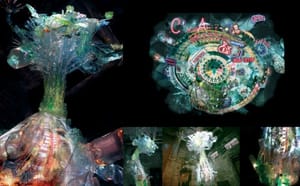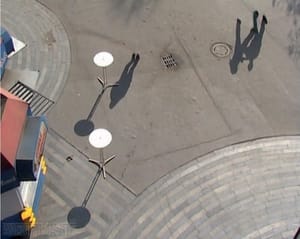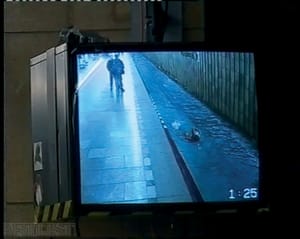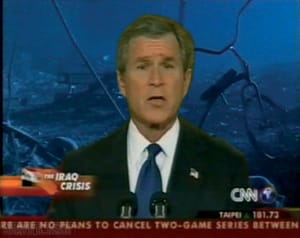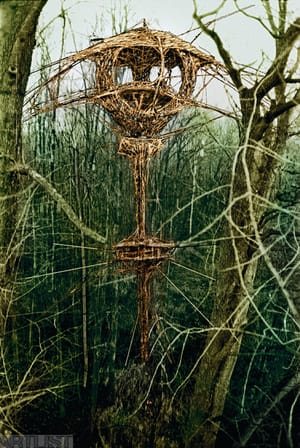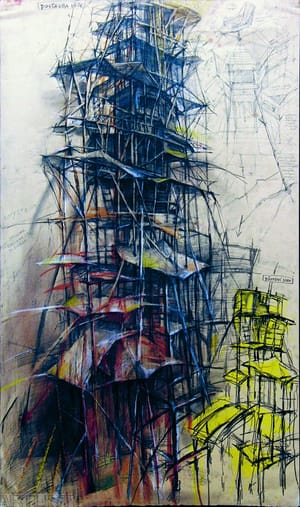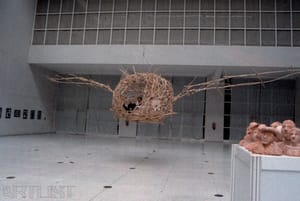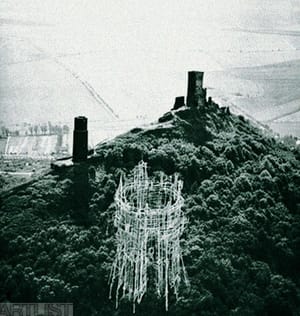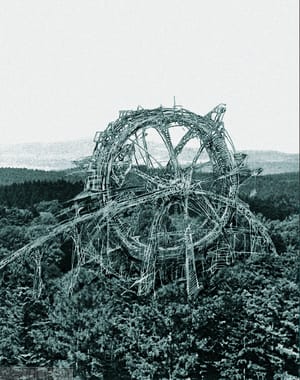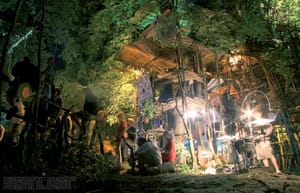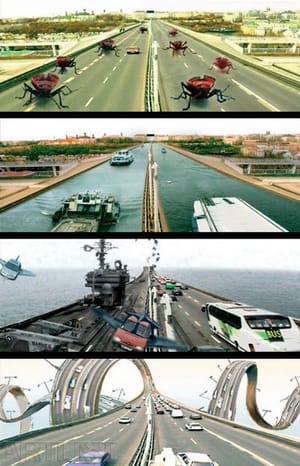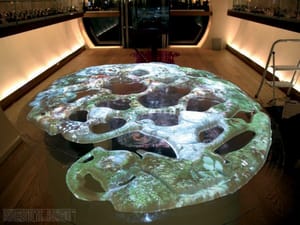- First Name
- Jakub
- Surname
- Nepraš
- Born
- 1981
- Birth place
- Prague
- Place of work
- Prague
- Website
- www.jakubnepras.com
- Keywords
- CSU Library
- ↳ Find in the catalogue
About artist
Jakub Nepraš (1981) entered the awareness of Czech fine art scene already while he was studying at the Academy of Fine Arts in Prague which was primarily thanks to his specific use of new media – concretely his video montages, which enable the artist to view the issues of public space and urban context in general from a completely different and very distinctive perspective. While the artist’s early works can be classified as a form of disruption of the regular cycle of a big city, since 2005 the work of Jakub Nepraš has stabilized with a very specific artistic language, the objective of which, rather than disrupting this space, is an interest in the possibility for its processing, mirroring, as well as analyzing. The analysis offers a view of the complexity of the mechanisms and relations, which the urban context and city colossus not only form but also drive. His video collages, typical for this period, accent the industrially mechanic interpretation of a big city, depicting a complex network of relations in a form that resembles a complex machine the product of which, similarly as in the case of the functioning of a neoliberal economy, is a never ceasing production. Realistic shots from the city life are interwoven here with detailed views of parts of an electric generator (Generator p-730, 2005), resembling, with its architectonic character, the landscape of a big city. Man is portrayed here as a miniature but inseparable part of this cycle: human individual not only participates on the functioning of the colossus with his existence, but thanks to his “desire for consumption”, he also further drives it and develops it.
His project Babylon Plant from 2006 can be perceived as the breaking point in Jakub Nepraš’s work. While the technical principles of a video collage remain in their essence similar to his preceding work, the content gains organic nature and emphasizes the rhizomatic character of the system, the functioning of which is specific for its organic branching, mutation, growth and energetic exchange between its parts, which imaginatively resemble a natural community – a world that is in many respects the opposite of a mechanical world, but simultaneously it is its modified prototype.
The picture element in the artist’s works becomes more complex with time and at first sight also more abstract. He not only uses more picture layers, but simultaneously starts to work with three-dimensional objects. Therefore, it is not a projection surface, but realistic spatial objects, which become animated by the projection (Magnetic Stone, 2011). The materials that the artist uses for his objects include various forms of modified plastics, resin, stones or wooden articles out of which he forms organic sculptures and complex structures. He accents not only the system, but also its community – the social and cultural level of society. We can encounter here the intermeshing of the living and the nonliving, the natural and the artificial. It is precisely this level that makes today’s work of Jakub Nepraš very current, especially in the context of today’s talked about post-humanistic discursus. His current work is actually not just an illustration of the phenomena of current life, but a form of analysis that makes it possible to get a glimpse of the processes and consequences, which influence current being. The information and virtual components that are part of today’s everyday reality penetrate to the front. Nepraš creates a theme of the influence of this reality on the cognitive bearings of the human mind (Brainstorming, 2007/ Reaktor, 2008), but also their influence on the homogenization of the cultural environment and human identity, which is, in the maze of the constant flow of information, subjugated to unceasing multiplication.
In spite of the strong visual aspect, which is symptomatic for the work of Jakub Nepraš, there is another element of his work of no less importance – the sound track, which accents the dynamic character of the portrayed and simultaneously enables the objects to further penetrate and merge with the space, which they are essentially an inseparable part of. Since 2010, we can observe in Nepraš’s work his inclination to give structure to his selected objects and at the same time his deeper interest in interconnecting them with a natural community (Moth, 2013 / Milestone, 2012). The organic component is not only an informational level of the actual projection, but it is also evident in his use and processing of material, which often appears as a nostalgic memory of the increasingly suppressed natural world, the residues of which can hardly win the battle with virtual reality of today and no less virtual tomorrows.
The work of Jakub Nepraš is represented in a number of world collections and it has been presented as a part of many international exhibitions of (not only) contemporary art. The topicality of his work should certainly not be reduced strictly to the topics that the artist works with, but it should be concentrated primarily on strategies and techniques, which Jakub Nepraš can speak to the viewer with – his combinatorics of a language is not only the key to grasp his work, but also an explanation why his work is so current today.
- Author of the annotation
- Markéta Stará Condeixa
- Published
- 2015
CV
Studies:
2001-2006 Academy of Fine Art, Prague
(2004-2006 studio of New media of professor Michael Bělický ZKM Karlsruhe
2002-2004 studio of New media Veronika Bromová, Prague,
2001-2002 studio of Monumental creation prof. Aleš Veselý, Prague)
1996-2000 Václav Hollar School of Art. Studies of figurative drawing, painting, sculpture, ceramic, advertising and computer graphics, printing graphics techniques, Prague
1994-1995 Secondary School Náhorní, domain Advertising artist, Prague
Stipends:
2004 residency at the Academy of Performing Arts, Prague (FAMU),
Institute of Animation creation, Prague, CZ
Awards:
2014
Nomination Dorothea von Stetten Kunst Preis, Bonn D
2007
Euromobile Prize for best work at the Arte Fiera Bologna, IT
Essl Award, 2nd prize
International Biennale Florence, 3rd prize
2005
Essl Award 4th prize
2007
Euromobile Prize for best work at the Arte Fiera Bologna, IT
Essl Award, 2nd prize
International biennale Florence, 3rd prize
2005
Essl Award 4th prize
Exhibitions
- Solo exhibitions
-
2013
Landscape, Arthobler gallery, Zurich, Swizz
2012
Ladscape, huntkastner gallery, Prague, CZ
2011
Jakub Nepraš, Gallery Waldburger gallery, Brussels, Belgium
Jakub Nepraš, Prague House, Brussels, Belgium
3E, Arthobler gallery, Porto, Portugal
2009
Sediment, „Interlinked Sediment, Active Sediment, Cultures, Generator p-730“, Galerie Alain Le Gaillard, Paris, France
Sediment II, „Sediment Sphere, Cultures, Reactor, Trip, Generator p-730“, Arthobler gallery, Porto, Portugal
Sediment II, „Sediment Sphere, Cultures, Reactor, Trip, Generator p-730“, Arthobler gallery, Lisbon, Portugal
Processes, „Active Sediment, Labo Relief, Auras of Communities”, Trafo gallery, Prague, CZ
- Group exhibitions not included in ARTLIST.
-
2013
Prague Biennale 6, Expanded Painting, curated by Helena Kontova, Giancarlo Politi and Nicola Trezzi, Freight Station Zizkov, Prague, CZ
À la recherche de la bohème perdue, curated by Divo institute and CAN, CAN (The Art Center Neuchatel), Swizz; NTK gallery (National Library of Technology), Prague, CZ
Tři z Trafačky, curated by Magdalena Deverová, Galerie moderního umění, Roudnice nad labem, CZ
Po Sametu, long term exhibition, curated by Karel Srp and Sandra Baborovská, 17.11.2009 – 2013, City Gallery Prague – The Golden Ring House, Prague, CZ
2012
SPOTLIGHTS video.kunst, Essl Museum, curated by Anna Szöke, Andreas Hoffer, Klosterneuburg/Wienna, Austria
FRAMEART festival, CAAA, Guimaraes, Portugal
Generátor, „Generator p-730“, Galerie Emila Filly, Ústí nad Labem, CZ
Hamburg Art week, Hamburg, DE
Freeze fest, cultural festival, Bartošovice, CZ
Po Sametu, long term exhibition, curated by Karel Srp and Sandra Baborovská, 17.11.2009 – 2013, City Gallery Prague – The Golden Ring House, Prague, CZ
2011
Una Nueva Aventura, SIART Biennale 11, curated by Norma Campos Vera, Fundación Visión Cultural, La Paz, Bolivia
Spaceship earth, Centre of Contemporary Art Znaki Czasu, curated by Dobrila Denegri, Torun, Poland
Výběr/Selection, Mikulov Symposium, curated by Petr Zubek, Malostranská beseda; Prague
Culturas – Viaje, Espacio de Arte Contemporáneo, Monte Video, Uruguay
Illuminationsfestival Lichtströme, organized by Bettina Pelz and Tom Groll Koblenz, DE;
Contemporary Czech Video Art, Piazzetta of the National Theatre, Prague Quadriennale, Prague, CZ
PAF festival, New York, United States of America
Po Sametu, City Gallery Prague – The Golden Ring House, Prague, CZ
2010
And_Writers, First Nanjing Biennale, curated by Zhu Tong, Wonil Rhee and Eleonora Battiston, Jiangsu Provincial Art Museum, Nanjing, China
Repair – ready to pull the lifeline, Ars Electronica 2010 – Festival for Art, Technology and Society, Linz, AU
DIGIFESTA 2010, curated by Wo-nil Rhee, Gwangju Biennial, Korea, Gwangju City Museum, Korea
About Architecture, curated by Georg Elben, Plan project 10 – Forum aktueller Architektur in Köln, DE
Fruits of Civilization, curated by Lenka Lindauerová, EXPO 2010, Czech Pavilion, Shanghai, China
Video Art Screening, Roppongi Art Night, Mori Art Museum, Tokyo, Japan
Transgression, curated by Gabriela Jurkovič, Videotage, Asia’s Media Art Organisation, Hong Kong
Po Sametu, City Gallery Prague – The Golden Ring House, Prague, CZ
2009
VIDEONALE 12 – Festival of Contemporary Video Art, curated by Susanne Hinrichs and Georg Elben, Kunstmuseum Bonn, DE
Spark Festival of Electronic Music and Arts, curated by Douglas Geers and Ali Momeni, University of Minnesota, Minneapolis, MN, USA
Waldburger gallery, Brussel, Belgium
Nanoscope, DOX Center for Contemporary Art, Prague, CZ
Eccentric Paths, curated by Sarolta Schredl, museum of art in Riga, Latvia
V. Zlínský salon mladých, Galerie výtvarného umění v Zlíně, CZ
My Europa, curated by Eva Eisler, EESC, Brussel, Belgium & DOX, Prague, CZ
Po Sametu / After Velvet, GHMP: Prague City Gallery, House of the Golden Ring House, Prague, CZ
GEH 8, Our house is your house, Dresden, DE
1989: The End of History or the Beginning of the Future, Austrian Culture Forum, New York, USA
Narracje, Installations and Interventions in Public Space, curated by Bettina Pelz, Gdansk, PL
Destination X, Museum of World Cultures, Göteborg, Sweden
Second Nature, curated by Simona Vladíková, Galerie kritiků, Prague
Spectator Novus, Palace Adria, Prague, CZ
Nanoscope, University of science, Pardubice, CZ
2008
Names, graffiti and street art festival, organized by Trafačka, Prague, CZ
Jung and digital, Byblos gallery, Verona, Italy
Code 5808, Laterna Magika, Prague, CZ
Second Nature, Východočeská galerie, Pardubice, CZ
2007
5+kk, Trafo gallery, Prague, CZ
Cultures (long-term installation), Laterna Magika Theatre, Prague, CZ
Essl Award Winners 2007, Essl Museum, Klosterneuburg/Wienna, Austria
Eccentric Paths, curated by Sarolta Schredl, Museum Colecção Berardo, Lisbon, Portugal
International biennale Florence, Florence, Italy
Space for imagination, “Generator p-730″, National Gallery, Prague, CZ
Young and Digital, Byblos Gallery, Verona, Italy
2006
Mycelium, curated by Jiří Machalický, Gallery Montanelli, Prague, CZ
“Plant Flower”, old hall of train station, Plzeň, CZ
Graduates of the Academy of Fine Arts in Prague, National Gallery at the Veletržní Palace, Prague, CZ
Academy of Science, Prague, CZ
Trafačka Arena, Prague, CZ
Viper festival Basel 06 , Basel, Switzerland
Sperm festival, club Abaton, Prague, CZ
Transmediale Berlin, Berlin, Germany
NEMO festival, Paris, France
2005
Viper festival Basel, Basel, Switzerland
Entermultimediale – festival, organized by CIANT, Prague, CZ
Essl Award, Essl Museum, Klosterneuburg/Wienn, Austria
Autostadt Screen, Wolfsburg, Germany
OPTRONICA – festival of short films, London, UK
2003
Swimmers on Subway, intervention in public space, Prague metro
2002
Faces of the City, intervention in public space, Prague metro
- Collections
-
Artphilein Foundation, Vaduz, Liechtenstein
Essl Museum, Klosterneuburg/Vienna, Austria
Mikulov Collection, Mikulov, CZ
Museum Colecção Berardo, Lisbon, Portugal
National Gallery, Prague, CZ
Prague City Gallery, CZ
- Other realisations
2002-2006 Live VJ video performances to music
1998-2006 The ordering of alternative forest parties
Art fairs:
2010
The Solo project Basel, “Reactor, Sediment Sphere, Trip”, Basel, Switzerland
2009
Art Vilnius 09, „Trip, Cultures”, Vilnius, Lithuania
2008
Next art fair, ”Ayahuasca, Trip”, Chicago, United States of America
Basel Art Fair, ”Trip, Brainstorming”, Basel, Switzerland
Art Fair, ”Trip, Brainstorming”, during Film Festival in Cannes, France
Monography
- Monography
Personal Catalogue 2008
Texts by Jakub Nepraš, translations by Steven Rusling, Marek Tomin, designed by Jakub Nepraš, Jakub Sýkora, edited by Vernon gallery
Catalogues:
2011
SIART Biennale, catalogue of exhibition, La Paz, BoliviaSpaceship earth, Centre of Contemporary Art Znaki Czasu, catalogue of exhibition, Torun, Poland
2010
Nanjing Biennale, catalogue of exhibition, Nanjing, ChinaARS Electronica, catalogue of exhibition, Linz, Austria
Plan project 10, catalogue of exhibition, Köln, Germany
Gwangju Biennale – Digifesta 2, catalogue of exhibition, Gwangju City Museum, Korea
Po Sametu, catalogue of exhibition, City Gallery Prague – The Golden Ring House, Prague, CZ
2009
Po Sametu, catalogue of exhibition, City Gallery Prague – The Golden Ring House, Prague, CZZlínský salon mladých, catalogue of exhibition, Zlín, CZ
Spectator novus, catalogue of exhibition, Palace Adria, Prague, CZ
Second Nature, catalogue of exhibition, Palace Adria, Prague, CZ
2008
Second nature, catalogue of exhibition, Východočeská gallery, Pardubice, CZNames, catalogue of graffiti and street art festival, Prague, CZ
Tina-B, catalogue of international festival, Prague, CZ
2007
“5+kk”, catalogue of exhibiton, Trafo gallery, Prague, CZEssl Award, catalogue of exhibition, Essl Museum, Klosterneuburg/Wienn, Austria
Museum Colecção Berardo, catalogue of exhibition, Lisbon, Portugal
International biennale Florence, “Liana”, 3. prize, Florence, Italy
Tina-B, catalogue of international festival, Prague, CZ
2006
Diploma work, “catalogue of diploma works from Academy of Fine Arts, National Gallery, Prague, CZ2005
Essl Award, catalogue of exhibition, Essl Museum, Klosterneuburg/Wienn, Austria
- Articles
Sedlák, Pavel: Nové umění z kráteru, A2 kulturní týdeník, 40/2008




